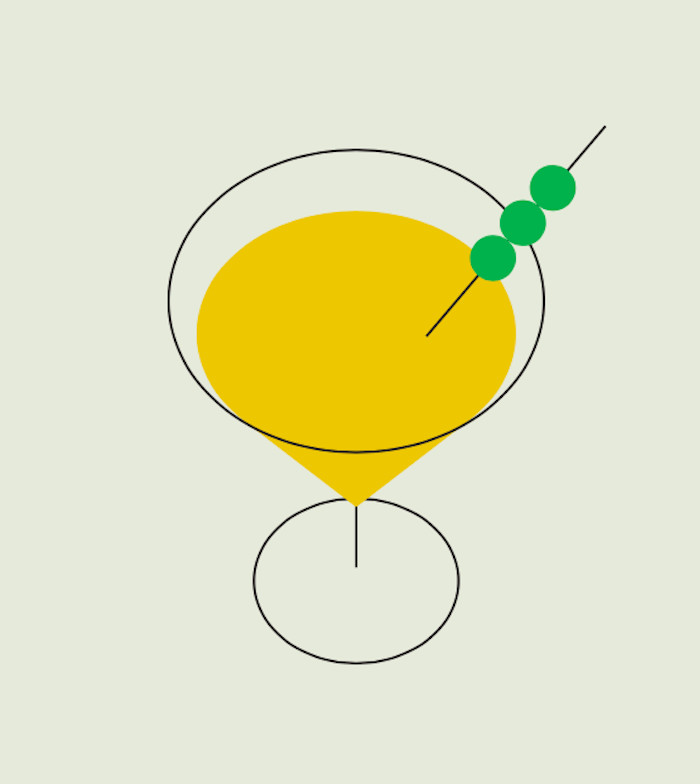
A cocktail's name can be instrumental to its success. Who better than pioneer of cocktail puns Jake Burger to guide us through the nomenclature?
The pioneer bartenders of the 19th century had a pretty functional attitude to naming their drinks. If it was a cocktail and it was made from brandy it was a Brandy Cocktail, if it was a sour and it was made from rum it was a Rum Sour. And as more exotic ingredients were added to the bartender’s lexicon, the names expanded accordingly – a dash of absinthe elevated the humble Whiskey Cocktail to the Improved Whisky Cocktail, a twist of lemon zest and a slightly nicer glass transformed the mundane Gin Cocktail into the Fancy Gin Cocktail.
By the time bartenders decided to add vermouth to their recipes, well, a request for A Fancy, Improved Whiskey & Vermouth Cocktail would’ve told the bartender exactly which drink was required, but it is undeniably a bit of a mouthful, especially after the second one. So shorter, catchier names were contrived: say hello to the Manhattan, the Martini, the Sazerac and, of course, over the ensuing decades innumerous more.
It is worth mentioning, as an aside, that some people lusted only for the drinks of the past, not the multiingredient concoctions on which avant-garde 19th-century bartenders built their reputations. Hence the Old Fashioned Whiskey Cocktail, a name which was quickly truncated to, well… you get the picture.
I’ll confess to a slight oversimplification. In the very first ‘cocktail book’, Jerry Thomas’s landmark 1862 Bartenders Guide, there were two drinks that had already gone down the esoteric route – the distinctly non-Nikkei Japanese Cocktail, and the somewhat more aptly named Jersey Cocktail, neither of which survived with any great fame into the modern age. So that’s the potted history. How then should the 21st-century bartender name their drinks? There are a handful of paths to choose from.
So that’s the potted history. How then should the 21st-century bartender name their drinks? There are a handful of paths to choose from.
The Salacious Route
It is tempting to presume the Disco Drinks era to be the heyday of this category – the Sex on the Beach and Sloe Comfortable Screw Up Against The Wall being perhaps the most enduring of their oeuvre (note to the uninformed, it’s Sloe because it contains Sloe Gin, it’s Comfortable because of the Southern Comfort, it’s a Screw because it contains the Screwdriver’s vodka and orange, and it’s Up Against the Wall because it contains the Harvey Wallbanger’s Galliano – but I digress).
In the modern era it’s also worth considering people’s feelings, and their unending knack of taking offence when going down this path. The wise bartender might think it best to leave it.
The Pun Route
I am narcissistic enough to appoint myself as the progenitor of this category, my 1998 Pisco Inferno being the earliest pun-based cocktail I’m aware of. But goodness, if it was indeed the original worm, well, what a can of them it opened. Somewhere on my hard drive I have a several hundred-strong list of punbased cocktails harvested from a long since forgotten Facebook thread. I think Gareth Evans started it, and he subsequently turned it into a career, his zenith perhaps being reached with Greengage Mutant Ginger Myrtles. I gave up at that point and vowed never to use puns on a cocktail list again, until last month when one of my colleagues invented a non-alc version of the Penicillin and dubbed it the Amoxicillin. Y’know because it’s a Mocktail – eat yer heart out Evans.
The Minimalist Route
It seems for many modern drinksmiths the temptation is to make all your drinks look like a fancy glass of water. Cocktails with clear liquid served in an impossibly delicate rocks glass, over a gigantic clear ice block (as fellow contributor Kevin Armstrong recently and eloquently described in this publication) tend to bear names as monochromatic as their colour palettes: Beeswax, Apples (which was admittedly a cool drink when it first emerged), Forest, or if you really want to alienate your guests then something they’ve never even heard of, like Geosmin. Bored of it. Next!
The Modern Functional Route
Like the aforementioned Fancy and Improved cocktails of yesteryear, adding a descriptive appendage to a classic or existing cocktail can work. The lesser-seen White Negroni springs to mind, as does the Mezcal Margarita. It’s an efficient way of telling your guests exactly what they’re going to get without burdening them with the reading or understanding of the rest of the ingredient list. In many ways it’s beautiful in its elegance and succinctness. Sure it’s a tad lazy, and oftentimes it has been abused. Is your oh-so-clever reimagining of the Negroni still a Negroni if it doesn’t contain any gin, sweet vermouth or Campari? I don’t know, you decide.
The poor old Martini has suffered this fate more than most, and certainly more than she deserved. The Strawberry/Chocolate/Appletinis of the late ’90s had little, if any, DNA in common with the masterful original. Most of them, it must be said, were mercifully short-lived but a handful live on – the ever popular Pornstar and Espresso as discussed elsewhere herein, and Ben Reed gets a pass for his Pineapple Martini too, but mostly just because he’s Ben Reed.
The late lamented Gregor de Gruyther deserves an honourable mention here for his high-octane Nuclear Daiquiri, a second serving of which transformed into an Unclear Daiquiri, due to its sobriety inhibiting nature, combining both the pun-based and the modern functional routes to great effect. Bravo sir!
The Esoteric Route
The poet’s choice, the romantic’s choice, the best choice. Just come up with a catchy name and if there is an obscurely relevant link to the drink, or the venue it calls home, that enables nerds like myself to display their useless knowledge then all the better, though certainly not essential. Cubes at the shuttered Wacky Wombat fell nicely into this department. If you didn’t ‘get it’, look up ‘wombat shit’ on Google… It helped that it’s damn tasty too, – the drink that is.
I went through a phase in the ’90s of naming drinks after famous people (and a dog) from history. The Raspberry Marciano, The Vanilla Laika and the Absolut Edison, I’ll not bore you with the barely valid excuses for those names, buy me a beer and I might. Was I the master of the esoteric route? I was not. I once named a drink after the font I was typing the menu in.
Lots of our ‘modern classics’ from folks more talented than I might fall into this group; the Paper Plane, the Naked and Famous, the Penicillin. So too the great majority of the ‘original classics’, including most of the drinks which have names far better than their recipes deserve; the Aviation, the Sidecar, the Blood & Sand.
Of course, history teaches us that it’s not really up to us anyway. Dick Bradsell originally called his most enduring creation the Vodka Espresso, changed it to the Pharmaceutical Stimulant at the behest of his employer at Pharmacy, before giving in to the will of the people and accepting the Espresso Martini moniker we all use today. Much, one imagines, to his chagrin. Dick was actually great at esoteric names, see the Bramble, the Wibble, and the Snood Murdekin.
Is it worth worrying about? Well, kind of. When St Germain first came out we put an Elderflower Collins on the menu at Jake’s and nobody ordered it, when we changed it to the Phil Collins its popularity grew exponentially. The right name can certainly have a positive effect on a drink’s immediate success in the bar, and if there is a part of you that yearns to create a drink that will outlive your bar, or even perhaps yourself, then nomenclature is an important consideration.
It’s a truism that people remember a great night longer than they remember a great drink, and the same is undeniably true of a great name. The Solero at Lab had all the same flavours as The Pornstar Martini and was, in my opinion, a drink far more deserving of longevity than the latter, but it had a crap name. If you’re really in the legacy business there is one more, albeit risky, route to consider:
The Eponymous Method
Further back in history the great John Collins probably didn’t name his drink after himself, he just called it Punch, or Gin Punch, or at a real push Limmer’s Gin Punch – it was his admiring guests who decided to name it after the man himself. Then somewhere in the noisy, illiterate midst of the 19th century, the rest of world decided it was called the Tom Collins, cruelly condemning his very name to relative obscurity. The erstwhile Leonardo Valdorini of Harry’s Bar, Florence, suffered an even worse fate. He claimed that the Bellini was his finest creation but once shared with me words to the effect: “Those bastards at Harry’s Bar in Venice stole it and changed the name.” What should it actually be called? Well, The Leonardo, of course, but like I said, it’s not really up to us.


